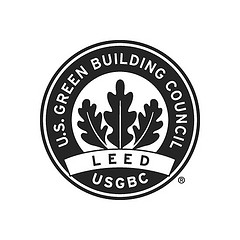
Buildings, homes and offices are one of the biggest contributors to global warming due to the amount of energy they consume. To combat this, more and more companies are slowly but surely introducing environmentally friendly materials and practices into their buildings. Buildings with enough green claims are accredited as LEED Certified. Designed by the U.S. Green Building Council, the Leadership in Energy and Environmental Design (LEED) standards score a building’s sustainability based on water efficiency, sustainable sites, energy and atmosphere, materials and resources, indoor environmental quality, innovation in design, and regional priority.
Among the highest-ranked groups in the recent certification were Seventh Generation, Nestlé, and the Hurt building which all received a LEED Gold certification. A few others, including the Tower headquarters and the University of Florida, were awarded LEED Platinum certifications. Although some of the certifications are the first of their classes, most of the sustainable LEED buildings look exactly like normal offices, meaning sustainability doesn’t have to imply sacrifice; in fact, the differences are most noticeable in increased productivity, lower costs, and higher employee morale.
Seventh Generation
Vermont-based corporate responsibility advocate and natural product distributor Seventh Generation qualified for LEED Gold with its new 19,000 square-foot headquarters building. Seventh Generation worked with Maclay Architects of Waitsfield, Vt., in selecting local, sustainably harvested wood, recycled workstation and insulation materials, VOC-free paints, toxic fume-free fiber carpets, natural daylighting, water- and energy-saving technologies, composting and recycling services, and other green factors.
The new building promotes good mental and physical health by conserving resources and offering a natural work environment of informal open work spaces.
Nestlé
Pennsylvania gets its first food-manufacturing LEED building with the new Nestlé Water Pure Life plant in Allentown, Pa. It is also Nestlé’s first LEED Gold building, despite having six plants with LEED Silver ratings throughout the country. The plant contains high efficiency lighting, HVAC, and control systems that amount to 9.9 BTUs of saved energy every year. 75 percent of construction materials came from recycled construction waste. Other water management fixtures will help save 220,000 gallons of water annually, which is 55 percent above the requirement.
The Hurt Building
Despite being built in 1913, Georgia’s historic 18-story skyscraper attained LEED Gold certification for Existing Buildings: Operations and Maintenance. The 436,340 square-foot edifice now includes improved water and energy efficient fixtures, green cleaning practices, reduction of landfill waste, and sustainable exterior building management.
Tower
Tower’s corporate office building received LEED Platinum certification earlier this month for LEED for Commercial Interiors. Furthermore, its Tower Oaks building was awarded platinum for LEED for Core and Shell as the first ground-up construction in the region with such a rating. The Tower Oaks building was designed and assembled under the supervision of Lerner Enterprises of Rockville, Md., and was modeled with Vedic concepts of orientation, proportion and placement believed to improve health and increase work performance.
Autodesk Gallery
San Francisco’s Autodesk Gallery is only California’s second LEED Platinum building. The design software firm earned its certification after working with Anderson Anderson Architecture, with offices in Seattle and San Francisco, and HOK of San Francisco to renovate the gallery space.
The University of Florida
The University’s stadium reconstruction plan, called the Southwest Stadium Expansion and Renovation Project, will renovate 31,000 square feet of offices, meeting rooms, weight rooms, and reception areas, and will undergo new construction of 30,000 more square feet in environmentally friendly practices. The LEED Platinum rating, awarded in May this year, is Florida’s first platinum rating.

